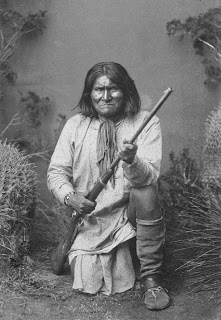 |
| Geronimo in 1887 |
Dateline February 17, 1909 – Apache Chief Geronimo dies from complications from pneumonia at Fort Sill, Oklahoma.
Geronimo surrendered in 1886 and spent his last years as a Prisoner of War of the ‘Merkin government. Despite his imprisonment he was still able to appear as a celebrity at various fairs and even rode in President Theodore Roosevelt’s 1905 inaugural parade. When he died at the age of 80, Geronimo was buried in the Apache Indian Prisoner of War Cemetery at Fort Sill.
Skip ahead a few years. The First World War — called the Great War until World War Two — was just breaking out. Prescott Bush — later a U.S. Senator and father of George Herbert Walker Bush, which makes him grandfather to George W. Bush — was stationed at Fort Sill before shipping out overseas. According to legend, Prescott Bush was one of several “Bonesmen” who dug up Geronimo’s bones and smuggled them to Yale University. They are said to have been at the Skull and Bones clubhouse ever since. G.H.W. Bush and G.W. Bush were later members of Skull and Bones, the secret society at Yale.
 |
| Edward S. Curtis, Portrait of Geronimo, 1905 |
There has never been a definitive answer as to whether Skull and Bones are keeping Geronimo’s bones. In 2009 Geronimo’s decendants sued. According to NBC News:
Geronimo’s great-grandson Harlyn Geronimo said his family believes Skull and Bones members took some of the remains in 1918 from a burial plot in Fort Sill, Okla., to keep in its New Haven clubhouse, a crypt. The alleged graverobbing is a longstanding legend that gained some validity in recent years with the discovery of a letter from a club member that described the theft.
[…] The letter, sent to F. Trubee Davison by Winter Mead, said Geronimo’s skull and other remains were taken from the leader’s burial site, along with several pieces of tack for a horse.
“The skull of the worthy Geronimo the Terrible, exhumed from its tomb at Fort Sill by your club and Knight Haffuer, is now safe inside the T[omb] — together with is [sic] well worn femurs, bit and saddle horn,” Mead wrote.
Geronimo’s decendants lost that suit, but on very narrow grounds that doesn’t solve the controversy:
Siding with an argument by the U.S. Department of Justice, a federal judge in Washington, D.C., held that the government hadn’t waived its sovereign immunity, and hence federal officials can’t be sued in the case to force them to permit Geronimo’s descendants to remove his remains still at Fort Sill and reinter them in New Mexico near his birthplace, reports the Yale Daily News.
And, as far as the secret society is concerned, U.S. District Judge Richard Roberts held that the law under which Skull and Bones was sued, the Native American Graves Protection and Repatriation Act, only applies to grave robberies that took place after its enactment in 1990.
However, that’s not the most recent insult to Geronimo’s memory. The mission to kill ‘Merkin Enemy #1, Osama bin Laden, was codenamed “Geronimo.” From USA Today:
“Obviously, to equate Geronimo with Osama bin Laden is an unpardonable slander of Native America and its most famous leader in history,” Harlyn Geronimo said in a statement to the Senate Committee on Indian Affairs.
The panel met Thursday in a session scheduled weeks ago to discuss how racial stereotypes — mainly in the form of team mascots’ nicknames — were offensive to Indians. But the issue quickly pivoted to the code name the military had given to the sponsor of the Sept. 11 terrorist attacks.
“This victory has otherwise united our country,” Indian Affairs Chairman Daniel Akaka, D-Hawaii, said of bin Laden’s killing. “It is unfortunate that this code name was chosen.”
Today Geronimo is not thought of as the terrorist he was depicted in his lifetime. There is now an understanding that Geronimo was one of the last of his proud tribe to take up arms to defend itself from the continued encroachment and broken treaties of the newest residents of North ‘Merka. Among Natives Geronimo is deservedly considered a hero. Let us hope that one day the truth of his bones becomes known.

